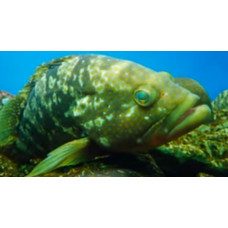Latin name
Epinephelus akaara
Other name
Epinephelus akaara
Identification
The body of the Hong Kong grouper is massive, oval in cross-section, covered with ctenoid scales along the midsection. The body length is less than the head length, 2.7-3.2 times less than the standard body length (in individuals from 11 to 38 cm long). Head length 2.3-2.6 times less than standard body length. Interorbital space convex. Forewing rounded, with small serrations, angular serration enlarged. Upper margin of gill cover straight; three strong flat spines on gill cover. Nostrils almost equal in size. Lower jaw protruding forward. Upper jaw perpendicular to posterior margin of eye. The lower jaw has 2 lateral rows of teeth; the teeth are small, almost equal in size, pointed. There are 8-9 gill stamens on the upper part of the gill arch and 15-17 on the lower part. Lateral line with 50-54 scales. There are 92-106 scale rows along the lateral line.
Features of fish fins
Long dorsal fin with 11 hard barb rays and 15-17 soft barb rays; the third to sixth barb rays are slightly longer than the others. The base of the soft part of the dorsal fin is shorter than or equal to the base of the barb. Anal fin with 3 hard and 8 soft rays. Pectoral fins with 17-19 rays, longer than the pelvic fins. The pelvic fins do not reach the anal opening; their bases are below the bases of the pectoral fins. The caudal fin is rounded.
Fish colouring
The head and body of the Hong Kong grouper are pale brownish grey, covered (except on the belly) with small red, orange or golden spots. There are 6 weakly defined oblique dark stripes along the upper part of the body: the first stripe on the nape of the neck, the third stripe merging into a dark brown or black spot on the body at the base of the last 3 spines of the dorsal fin, and the last stripe on the tail peduncle. The dark body stripes end at the base of the dorsal fin. The edge of the dorsal fin is yellow or orange; there is a dark yellow or orange spot on each of the membranes. There is a row of spots along the centre of the hard part of the dorsal fin and another row along the base of the fin. The soft parts of the dorsal, caudal and anal fins have faint red or orange spots at the base and their distal parts are dark with small faint white spots.
Distribution
Widespread in the western Pacific Ocean. Found from southern PRC and coastal waters of Taiwan; in the East China Sea to southern Japan.
Habitat
Benthic marine fish. They live over rocky reefs at depths down to 55m (juveniles down to 10m). Life expectancy up to 19 years.
Size
The maximum length of these fish is 58 cm, usually up to 30 cm; body weight up to 2.5 kg.
Behavior
Juveniles are often found at depths greater than 10 metres.
Food and feeding habits
Their diet consists of crustaceans, small fish, rock shrimps and crabs.
Reproduction
Like other members of the genus, they are successive protogynous hermaphrodites. All individuals are born female and only during the life cycle some individuals change sex and become male. Females mature at the age of 3 years with a body length of 23-24 cm. Off the coast of Korea they spawn in late July - early August. The eggs of these fish are pelagic, spherical in shape, 0.7-0.77 mm in diameter. The yolk is colourless, transparent, with a fat droplet. The incubation period at 25-27 ⁰C is 23-25 hours. The total length of the larvae at hatching is 1.45-1.56 mm.
Fishing
A highly prized food fish, usually caught by hand.
Relationship with a person
This fish can be found in live fish markets in Hong Kong.
| Classification | |
| Phylum | Chordata |
| Class | Actinopterygii |
| Squad | Perciformes |
| Family | Serranidae |
| Genus | Epinephelus |
| Species | E. akaara |
| Features | |
| Conservation status | Endangered |
| Habitat | Pelagic |
| Life span, years | 19 |
| Maximum body weight, kg | 2,5 |
| Maximum length, cm | 58 |
| Sailing speed, m/s | No information |
| Threat to people | Edible |
| Way of eating | Predator |
Hong Kong grouper
Tags: hong kong grouper


